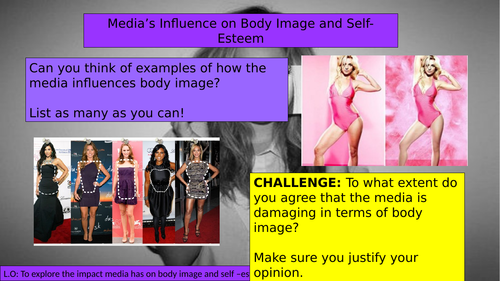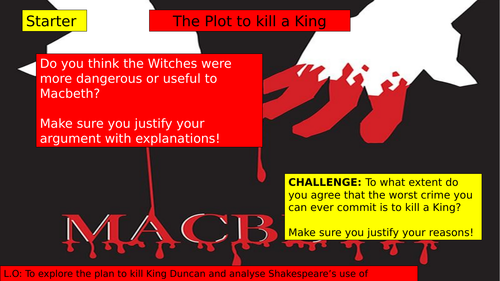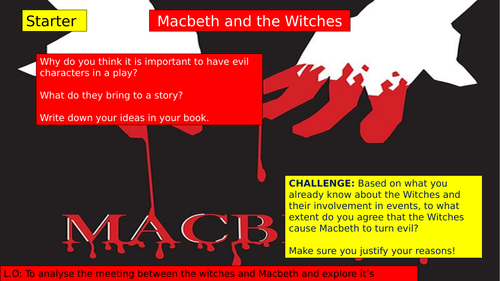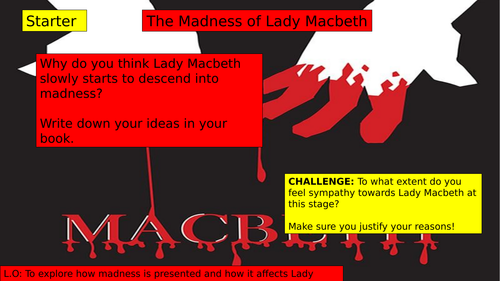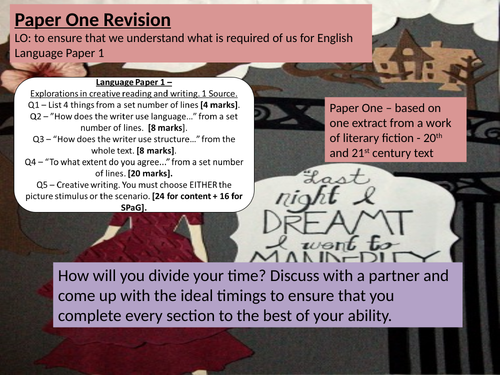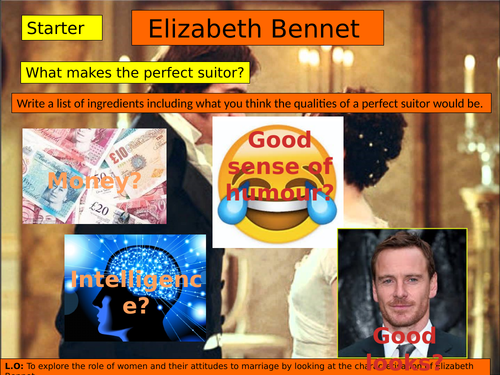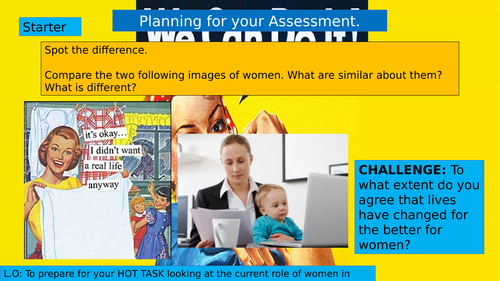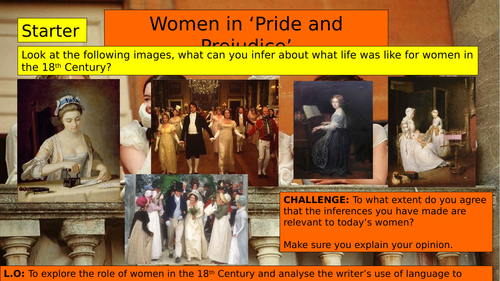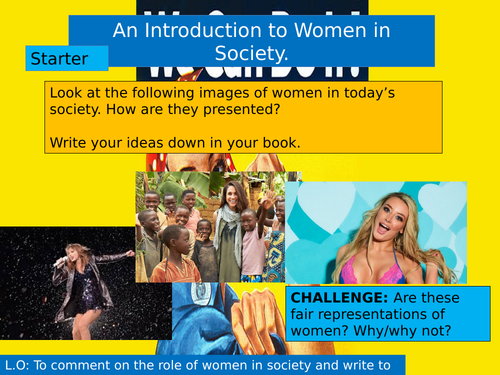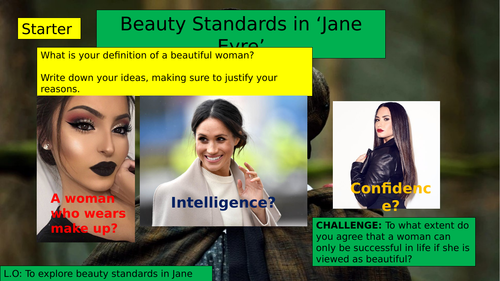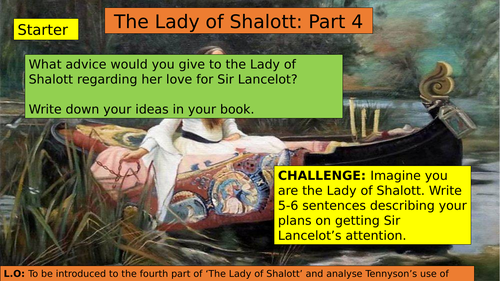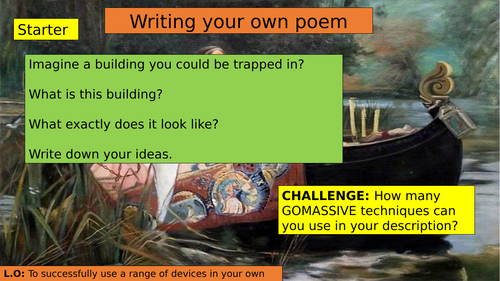60Uploads
19k+Views
4k+Downloads
English

(KS3 7/8/9) Media Influence on Body Image
This is a lesson planned for a middle-ability Year 9 class focusing on how the media influences body image. Pupils will discuss various images and the impact they have on teenagers and their body image. There is also a TED talk (link included in ppt notes) for pupils to watch on the influence of media. Pupils will then write a letter to Seventeen Magazine persuading them to stop body-shaming and focusing on skinny bodies. There are sentence starters included to support pupils in their writing. This lesson is easily adaptable for any KS3 class of any ability.
Bundle

KS3 (7/8/9) The Lady of Shalott Bundle
This bundle consists of 13 lessons worth of analytical and creative writing activities exploring the poem ‘The Lady of Shalott’ by Alfred Lord Tennyson. The lessons include activities supporting with selecting quote, identifiying language techniques and analysing quotes in more detail. In this bundle, there are also creative writing activities and opportunities for students to create diary entries and newspaper articles based on their studies. There are two assessments included in this bundle too where pupils will write analytical paragraphs about how Lady Shalott is presented, to track progress throughout this SOW.
ALL WORKSHEETS NEEDED ARE AT THE END OF EACH RELEVANT POWERPOINT.

Bertha from 'Jane Eyre' Diary Entry
This is a lesson for a middle-ability Year 8 class who were looking at Gothic literature. This lesson carries on from looking at an extract in ‘Jane Eyre’ where Bertha is finally revealed to the reader (see other Bertha lesson uploaded). The lesson requires pupils to imagine they are Bertha and write a diary entry detailing one of the days where she is locked inside the house/attic. There is an active activity where pupils can initially create a mime of Bertha, before they then plan and write their diary entry. Sentence starters are included to support pupils in their writing. This is easily adaptable for any KS3 or KS4 class.

GCSE POWER AND CONFLICT POETRY REVISION- TYPES OF CONFLICT
This is a GCSE lesson revision different types of conflict that the AQA Power and Conflict poetry cluster explores. The lesson features a range of activities that you can pick and chose from to suit your class. They range from pupils create tables to identify what poems link to different types of conflict; there is also a model text of the beginning of a comparison essay that pupils can highlight to identify the AOs and use to support their own writing.

Macbeth: Macbeth's uncertainty GCSE-style assessment
This resource consists of two lessons focusing on a GCSE-style assessment. This has been planned for a middle-ability Year 9 class. The lesson focuses on the idea of whether Macbeth is truly a victim or not and requires pupils to consider a GCSE-style question on this where they must analyse an extract but also comment on other parts of the play. The first lesson focuses on them exploring the extract and planning a response (planning sheet included focusing on a PEACE structure) and the second lesson is more brief, allowing them plenty of time to write their assessment. This resource is easily adaptable for any KS3 or KS4 class of any ability.

Macbeth: The Plot to kill a King
This is one whole lesson for a middle- ability Year 9 class focusing of Macbeth and Lady Macbeth plotting to kill King Duncan. The lesson focuses on a short extract from the scene and requires students to consider gender stereotypes during the Shakespearian era and how Macbeth and Lady Macbeth subvert them. The tasks are split into sections to make them more manageable and sentence starters are provided to support pupils in their writing. The extract for the lesson is also included and the lesson can be easily adapted to a KS3 or KS4 class of any ability.

Macbeth's first meeting with the Witches
This is one lesson for a middle-ability Year 9 class looking at the scene where Macbeth and Banquo first meet the Witches. The lesson predominantly focuses on the prophecies the Witches provide and the significance of these. The initial reactions of Macbeth and Banquo are also explored with supporting questions to answer. A model text of a paragraph responding to a GCSE-style question is also included, as well as the extracts of Macbeth and Banquo’s reactions. This can easily be adapted for any KS3 or KS4 class.

Macbeth: Exploration of Macbeth
This is a middle-ability Year 9 lesson focusing on the characterisation of Macbeth and Shakespeare’s use of symbolism through a dagger. The short ‘Is this a dagger I see before me?’ soliloquy is explored in the lesson (the extract is included). It has been divided into sections to make it more manageable for pupils to identify language techniques used and the consider the effect they create. Also included, is a short video of the Patrick Stewart performance to help pupils understand how the scene would be played out and to help them with their understanding of Macbeth. Sentence starters are also provided to support them with their writing. This lesson is easily adaptable for a KS3 or KS4 class of any ability.

Macbeth: Lady Macbeth's Madness
This is a middle-ability Year 9 lesson exploring the madness of Lady Macbeth. The extract of the crucial scene is included and pupils are required to consider how Lady Macbeth is presented in the scene and how they respond to her madness. T make it more manageable, a table has been provided that requires pupils to find evidence in the extract to support statements made and they will also need to identify language techniques used. There are also sentence starters provided to support pupils in writing an analytical response. This lesson is easily adaptable to a KS3 or KS4 class of any ability.

(KS4 10/11) Language Paper 1 Q1-4 'Rebecca'
These are a series of lessons planned for a middle-ability KS4 class. These lessons explore questions 1-4 of the Language Paper 1 exam individually. Pupils are able to practice writing responses to each question on an extract from ‘Rebecca’ (extract included). There are also tips and advice included on how to answer the questions and model texts to support pupils in writing their own answers. These lessons are easily adaptable for any KS4 class of any ability.

(KS3 7/8/9) Elizabeth Bennet
This is a lesson planned for a middle-ability Year 8 class looking at Elizabeth Bennet. Pupils will debate the role of women in the 18th Century before looking at the extract where Elizabeth rejects Darcy. There is support provided to help pupils annotate the extract and sentence starters to write a response about it. This lesson is easily adaptable for any KS3 class of any ability.

Women in Society Final Assessment
This is a lesson planned for a middle-ability Year 8 class looking at writing a persuasive speech giving a clear argument in response to a statement. Pupils will debate how important equal rights are and there are activities and a worksheet to help them plan their speech. There is then a success criteria and sentence starters to support them in writing their speech. This lesson is easily adaptable for any KS3 class of any ability.

(KS3 7/8/9) Women in 'Pride and Prejudice'
This is a lesson planned for a middle-ability Year 8 class. It explores the role of women in Jane Austen’s time and how women are presented in ‘Pride and Prejudice’. The lesson encourages pupils to analyse key quotes and begin to explore Language Paper 1 Q2 skills with the extract. There is also a model text to support pupils with their analytical writing. This lesson is easily adaptable for any KS3 class of any ability.

(KS3 7/8/9) Women In Society Opening Assessment
This is a lesson planned for a middle-ability Year 8 class. It is an introductory lesson looking at a Women in Society scheme of work. Pupils are encouraged to consider how women are currently presented in today’s society and pupils will write a speech presenting their point of view in response to a statement. This lesson can be easily adapted to any KS3 class of any ability.

(KS3 7/8/9) Beauty Standard in 'Jane Eyre'
This is a lesson planned for a middle-ability Year 8 class looking at beauty in ‘Jane Eyre’. Pupils will debate beauty expectations in the 19th Century before looking at key quotations exploring how Jane is described and the significance of Mr Rochester falling in love with her. There is support provided to help pupils write a paragraph on this through the use of a model text. This lesson is easily adaptable for any KS3 class of any ability.

KS3 (7/8/9) The Lady of Shalott Part Four
This is a lesson planned for a high-ability Year 7 class. The lesson focuses on part four of the poem of ‘The Lady of Shalott’ and aims to ensure that pupils understand the language used by Tennyson to create atmosphere. There is an activity supporting pupils in picking out key language devices. There is then an activity supporting pupils in writing analytical paragraphs on the first section using the PEACE structure and a model paragraph. This lesson is easily adaptable for any KS3 class of any ability.

KS3 (7/8/9) The Lady of Shalott Final Assessment
These are two lessons planned for a high-ability Year 7 class. The lessons focus on the whole ‘The Lady of Shalott’ poem and aims to ensure that pupils understand the language used by Tennyson to present the character of Lady Shalott. There is an activity supporting pupils in picking out key language devices and quotes. There is also support with sentence starters and a guide on how to use the PEACE structure for their paragraphs. This lesson is easily adaptable for any KS3 class of any ability.

KS3 (7/8/9) Writing a poem inspired by 'The Lady of Shalott'
This is a lesson planned for a high-ability Year 7 class. The lesson focuses on students writing their own poem, based on their studies of the poem of ‘The Lady of Shalott’ and aims to ensure that pupils understand the language techniques and structure that can be used in a poem. There is an activity supporting pupils in planning key language device, with a planning sheet included. This lesson is easily adaptable for any KS3 class of any ability.

Injustice themed bundle of lessons
This bundle consists of seven lessons focusing on the theme of ‘Injustice’, These English lessons were planned for a high-ability KS3 class, focusing on building key skills in relation to the English Language Paper 2 exam. The lessons focus on the #MeToo movement (involving an assessment to test pupils’ initial skills), two lessons focusing on the impact of Malala and writers’ differing attitudes to this and attitudes towards women in the media, as well as Martin Luther King’s famous speech. These lessons explore both analytical and creative writing skills and are easily adaptable for all KS3 class of all abilities.

